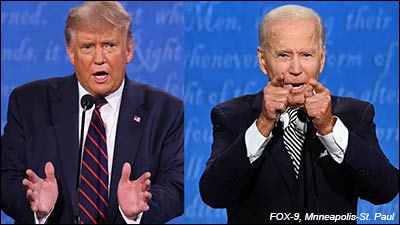By Jim Ellis — Friday, July 28, 2023
President
Presidential Trends: Biden, Trump Party Nominations Look Inevitable — Heading toward August of the off-year, we are seeing clear presidential trends already developing.President Joe Biden will be renominated. Despite Robert F. Kennedy Jr. being in the primary race and attracting some media attention, the Democratic process will almost assuredly be a non-event.
Trends are also clear for former President Donald Trump. He continues to lead in all polling and has actually gotten stronger within the party base after the series of indictments were leveled against him.
The Morning Consult data and research firm released a graph of the candidates’ progress from December of 2022 through the present. The latest result from their daily online track finds Trump now approaching 60 percent support nationally. In December, he was right at 50 support, but then generally dropped into the 40s through February but has continued to gain strength ever since.
The perennial second-place candidate, Florida Gov. Ron DeSantis, is now trending in the opposite direction. Beginning with 30 support national support in late December, Gov. DeSantis now finds himself languishing in the teens according to most GOP surveys.
The trajectory for most of the second-tier candidates has also been upward. Aside from Gov. DeSantis, who has fallen, and former Vice President Mike Pence and ex-UN Ambassador Nikki Haley, who have remained virtually stagnant, businessman Vivek Ramaswamy, Sen. Tim Scott (R-SC), and North Dakota Gov. Doug Burgum have all improved their standing. Ex-New Jersey Gov. Chris Christie has bolted onto the scene but appears to be running to deny Trump, and while he is moving into the middle of the pack, it is difficult to see how his support grows from the Republican Party’s relatively small “Never Trump” faction.
As we know, national polls do not deliver any delegate votes to the candidates. Those, of course, are won at the state level through public voting, so it is important to follow the state data to get a true indication of the nomination contest’s ebbs and flows.
Considering Trump’s national lead and the perception that he is the inevitable Republican nominee, his opponents must mount an attack early to bring him back to the pack. It’s hard to see, at this point, how such an affront develops, however.
It is also difficult to see what negative point can be made about the former president that hasn’t already been made. Furthermore, the argument that Trump is un-electable in the general election is even difficult to make in this early going with national polls showing him virtually dead even with Biden. As the election cycle unfolds, his electability may well be questioned but currently the data suggests that he is competitive.
Looking at the first two states, Iowa and New Hampshire, the Trump polling margins are commensurate with what we are seeing nationally.
Four Iowa polls have been released in July from three different pollsters, and Trump leads in all of them. His margins are from 23 to 30 points, and his support factor ranges in a tight span from 42 to 46 percent. The best any of his opponents can do is 21 percent (DeSantis), achieved once, and in the earliest July poll.
In the Granite State of New Hampshire, the pattern is similar with the exception of one poll that is likely an anomaly. Here, four July research studies were commissioned from four unique pollsters and the Trump advantage ranges from 14 to 37 points, with no opponent scoring more than 23 percent (DeSantis again). The one poll that showed the lead dropping to 14 points, while the others posted Trump advantages of 24, 27, and 37 percentage points, came from the University of New Hampshire’s online program.
The DeSantis campaign has been particularly disappointing. And, unlike some of the others – meaning Scott, Ramaswamy, and Burgum – who are concentrating virtually all of their time in Iowa and New Hampshire, Gov. DeSantis is making appearances in multiple states. At the end of the day, however, if Trump is not headed downward in one of the first two voting states, the race will likely be over.
The time frame is even shorter than usual. Iowa has moved its caucus vote from Feb. 5 to Jan. 15. New Hampshire is expected to ignore the Democratic National Committee schedule, which will begin in South Carolina on Feb. 3, and vote on or around Feb. 6. Nevada, which should vote third, will schedule their voting event before the South Carolina Republicans vote on Feb. 24, and most likely on Feb. 17. Michigan will then hold a primary for both parties on Feb. 27. Then, it’s onto Super Tuesday on March 5.
Super Tuesday is typically one that settles the race, but the 2024 Republican contest could be effectively decided before the calendar even enters March.
Also, according to polling, most voters won’t consider an Independent presidential candidate. A great deal of media attention has been paid to the possibility of an independent or minor party presidential candidate taking a significant vote share in the 2024 election. According to a Daily Kos/Civiqs research organization poll (July 22-25; 1,154 US registered voters; online), 66 percent of the respondents, including 78 percent of Democrats, 68 percent of Republicans, and 50 percent of Independents would not vote for such a candidate.
As the Civiqs analysis pointed out, in their January 2023 national survey, 62 percent said they did not want to see Biden run again, and 59 percent said the same about Trump. Though we may see ancillary candidates emerge, it is likely that this election will follow the same pattern as almost all others, that is, the race will come down to a decision between the two major party nominees.

